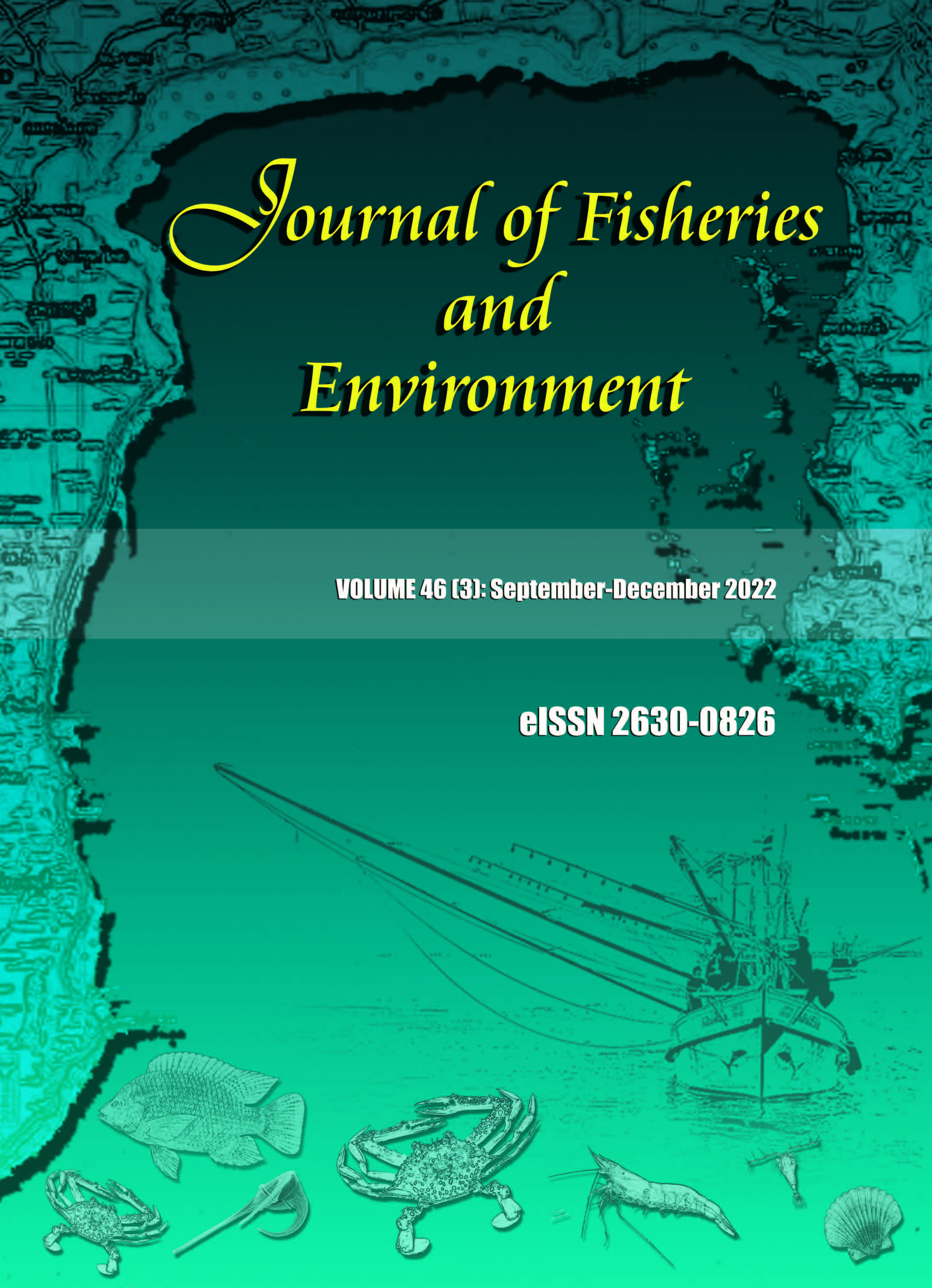Ecomorphological Comparison of the Brain in Different Species of Fish from the Persian Gulf
Main Article Content
Abstract
The present study aimed to compare the brain structure of 14 fish species with different ecological characteristics from the Persian Gulf. After precise dissection of the brain and weighing, fixation was performed using Bouin's solution, followed by tissue processing, embedding in paraffin, sectioning to a thickness of 12 μm, and staining with hematoxylin and eosin. Sections were observed under microscope and photographed to precisely describe the brain structures. The results showed that the grey bamboo shark (Chiloscyllium griseum) differed considerably in structure of the brain compared to bony fish, and it showed the highest brain-to-body mass ratio (0.8±0.02) (p<0.05). The crista cerebellaris and granular section were more obvious in the croaker (Otolithes ruber), maybe due to its well developed lateral line. A plankton-feeding shad, Tenualosa ilisha, had less brain-to-body mass ratio and a more simple structural brain compared to the narrow-barred Spanish mackerel (Scomberomorus commerson), which occupies the top of the food chain. Moreover, duskytail grouper (Epinephelus bleekeri), living in the coral reef ecosystem, had a greater brain-to-body mass ratio and more complex brain structure compared to flounders occupying a simpler environment. This study highlights that phylogenetics, trophic level, and complexity of environment have important relationships with brain anatomy of fishes in the Persian Gulf.
Article Details

This work is licensed under a Creative Commons Attribution-NonCommercial-NoDerivatives 4.0 International License.
References
Ari, C. 2011. Encephalization and brain organization of mobulid rays (Myliobatiformes, Elasmobranchii) with ecological perspectives. The Open Anatomy Journal 3(1): 1-13.
Bani, A.F. and N. Jadidi. 2008. Brain morphology in Acipenser stellatus and Acipenser persicus. Iranian Journal of Biology 21(2): 341-350.
Cairó, O. 2011. External measures of cognition. Frontiers in Human Neuroscience 5: 108. DOI: 10.3389/fnhum.2011.00108.
Compagno, L.J. 2001. Sharks of the World: An Annotated and Illustrated Catalogue of Shark Species Known to Date, 1st ed. Food and Agriculture Organization of the United Nations, Rome, Italy. 269 pp.
Deary, A.L., B. Metscher, R.W. Brill and E.J. Hilton. 2016. Shifts of sensory modalities in early life history stage estuarine fishes (Sciaenidae) from the Chesapeake Bay using X-ray micro computed tomography. Environmental Biology of Fishes 99(4): 361-375.
Eastman, J.T. and M.J. Lannoo. 2007. Brain and sense organ anatomy and histology of two species of phyletically basal non‐Antarctic thornfishes of the Antarctic suborder Notothenioidei (Perciformes: Bovichtidae). Journal of Morphology 268(6): 485-503.
Edmunds, N.B., K.S. McCann and F. Laberge. 2016. Food web structure shapes the morphology of teleost fish brains. Brain, Behavior and Evolution 87(2): 128-138.
Fox, C.H., A.C. Gibb, A.P. Summers and W.E. Bemis. 2018. Benthic walking, bounding, and maneuvering in flatfishes (Pleuronectiformes: Pleuronectidae): New vertebrate gaits. Zoology 130: 19-29.
Gittleman, J.L. 1986. Carnivore brain size, behavioral ecology, and phylogeny. Journal of Mammalogy 67(1): 23-36.
Hasan, K.M.M., Z.F. Ahmed, M.A. Wahab and E.Y. Mohammed. 2016. Food and feeding ecology of hilsa (Tenualosa ilisha) in Bangladesh’s Meghna River basin, International Institute for Environment and Development, London, UK. 20 pp.
Kotrschal, K., M.J. Van Staaden and R. Huber. 1998. Fish brains: evolution and anvironmental relationships. Reviews in Fish Biology and Fisheries 8(4): 373-408.
Lecchini, D., G. Lecellier, R.G. Lanyon, S. Holles, B. Poucet and E. Duran. 2014. Variation in brain organization of coral reef fish larvae according to life history traits. Brain, Behavior and Evolution 83(1): 17-30.
Lee, B. and B. Mann. 2017. Age and growth of narrow-barred Spanish mackerel Scomberomorus commerson in the coastal waters of southern Mozambique and KwaZulu-Natal, South Africa. African Journal of Marine Science 39(4): 397-407.
Lee, H.T., B.Q. Huang and C.H. Liao. 2022. functional adaptation of vocalization revealed by morphological and histochemical characteristics of sonic muscles in blackmouth croaker (Atrobucca nibe). Biology 11(3): 438. DOI: 10.3390/biology11030438.
Lisney, T. and S. Collin. 2006. Brain morphology in large pelagic fishes: a comparison between sharks and teleosts. Journal of Fish Biology 68(2): 532-554.
Movahedinia, A., N. Salamat and P. Kheradmand. 2018. Effects of the environmental endocrine disrupting compound benzo [a] pyrene on thyroidal status of abu mullet (Liza abu) during short-term exposure. Toxicology Reports 5: 377-382.
Navarrete, A., C.P. Van Schaik and K. Isler. 2011. Energetics and the evolution of human brain size. Nature 480(7375): 91-93.
Nieuwenhuys, R., H.J. ten Donkelaar and C. Nicholson. 2014. The Central Nervous System of Vertebrates, 1st ed. Springer, Heidelberg, Germany. 327 pp.
Niven, J.E. and S.B. Laughlin. 2008. Energy limitation as a selective pressure on the evolution of sensory systems. Journal of Experimental Biology 211(11): 1792-1804.
Owfi, F. 2015. A review on systematic and taxonomic of the Persian Gulf fish species, based on geographical distribution pattern and habitat diversity, using by GIS. Ph.D. Thesis, Islamic Azad University, Tehran, Iran. 180 pp.
Pelvig, D., H. Pakkenberg, A.K. Stark and B. Pakkenberg. 2008. Neocortical glial cell numbers in human brains. Neurobiology of Aging 29(11): 1754-1762.
Ramcharitar, J., D.P. Gannon and A.N. Popper. 2006. Bioacoustics of fishes of the family Sciaenidae (croakers and drums). Transactions of the American Fisheries Society 135(5): 1409-1431.
Rodriguez, F., E. Durán, A.Gómez, F.M. Ocana, E. Alvarez, F. Jiménez-Moya, C. Broglio and C. Salas. 2005. Cognitive and emotional functions of the teleost fish cerebellum. Brain Research Bulletin 66(4-6): 365-370.
Schluessel, V. and H. Bleckmann. 2012. Spatial learning and memory retention in the grey bamboo shark (Chiloscyllium griseum). Zoology 115(6): 346-353.
Shu, D.G., S.C. Morris, J. Han, Z.F. Zhang, K. Yasui, P. Janvier, L.I.N.G. Chen, X.L. Zhang, J.N. Liu, Y.O.N.G. Li and H.Q. Liu. 2003. Head and backbone of the Early Cambrian vertebrate Haikouichthys. Nature 421(6922): 526. DOI: 10.1038/nature01264.
Sternberg, R.J. and J.C. Kaufman. 2013. The Evolution of Intelligence, 1st ed. Psychology Press, Taylor and francis group, New York, USA. 383 pp.
Striedter, G.F. 2006. Précis of principles of brain evolution. Behavioral and Brain Sciences 29(1): 1-12.
Yopak, K.E. and L.R. Frank. 2009. Brain size and brain organization of the whale shark, Rhincodon typus, using magnetic resonance imaging. Brain, Behavior, and Evolution 74(2): 121-142.


